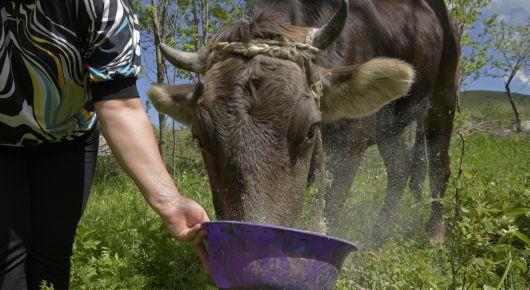FAO project aims to protect indigenous brown cattle breeds, farmer livelihoods in eastern Europe

Upon request from the governments of Armenia, Georgia and Ukraine, FAO has been helping these countries maintain the genetic diversity and sustainable use of local brown cattle breeds suitable for both dairy and meat production.
A two-day workshop starting today in Kyiv will provide an update on the process, present a plan for cattle breeding and share aspects of a genetic evaluation conducted of cattle in those countries.
Cattle, valuable for its meat and milk, is an important source of food in eastern Europe. Although intensive forms of cattle production are likely to encompass an increasing part of cattle production, cattle breeding is done almost exclusively by family farmers in all three of the programme countries, securing income for many smallholders. However, structural changes following the independence of Armenia, Georgia and Ukraine in the 1990s had strong negative effects on the support and development of local brown cattle breeds, leading to lower-grade animals and production. Many livestock producers lack sufficient resources or knowledge to practice professional animal husbandry.
The ongoing FAO support programme was developed to strengthen the livelihoods of cattle-producer families through the conservation and development of dual-purpose cattle breeds, including the Caucasian Brown and Carpathian Brown breeds. The project is focusing on local varieties, as these are adapted to the area’s geographical and climatic conditions – particularly in the mountainous regions – and can gratify needs for both meat and milk.
Although there are no official data on livestock numbers, it is suspected that the cattle population in the three countries has grown in recent years.
Project activities started with the collection of data, explains Tibor Szucs, an FAO animal production expert: “We gained information by visiting 100 farms, altogether, and vetting 300 cows and 20 bulls to assess the existing situation of genetic resources and their production systems. Examinations included modern phenotypic and molecular genetic characterization of the cattle populations concerned and their production environments.”
Based on the findings, a breeding strategy and development plans were drafted, addressing both the conservation and genetic development of the breed populations, as well as addressing the non-genetic aspects of breed development.
Workshop participants – including producers, government representatives and research specialists – will discuss the baseline documents during the workshop’s two days.
“The purpose is not only to protect an indigenous local livestock variety,” Szucs said, “but, by improving its genetic resources, to make the smallholder cattle production more sustainable in Armenia, Georgia, and Ukraine.”
11 September 2019, Kyiv, Ukraine
